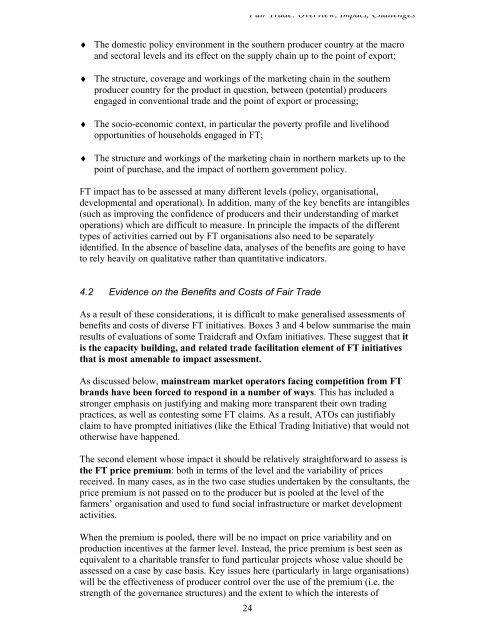Fair Trade: Overview, Impact, Challenges - Are you looking for one ...
Fair Trade: Overview, Impact, Challenges - Are you looking for one ...
Fair Trade: Overview, Impact, Challenges - Are you looking for one ...
You also want an ePaper? Increase the reach of your titles
YUMPU automatically turns print PDFs into web optimized ePapers that Google loves.
24<br />
<strong>Fair</strong> <strong>Trade</strong>: <strong>Overview</strong>, <strong>Impact</strong>, <strong>Challenges</strong><br />
♦ The domestic policy environment in the southern producer country at the macro<br />
and sectoral levels and its effect on the supply chain up to the point of export;<br />
♦ The structure, coverage and workings of the marketing chain in the southern<br />
producer country <strong>for</strong> the product in question, between (potential) producers<br />
engaged in conventional trade and the point of export or processing;<br />
♦ The socio-economic context, in particular the poverty profile and livelihood<br />
opportunities of households engaged in FT;<br />
♦ The structure and workings of the marketing chain in northern markets up to the<br />
point of purchase, and the impact of northern government policy.<br />
FT impact has to be assessed at many different levels (policy, organisational,<br />
developmental and operational). In addition, many of the key benefits are intangibles<br />
(such as improving the confidence of producers and their understanding of market<br />
operations) which are difficult to measure. In principle the impacts of the different<br />
types of activities carried out by FT organisations also need to be separately<br />
identified. In the absence of baseline data, analyses of the benefits are going to have<br />
to rely heavily on qualitative rather than quantitative indicators.<br />
4.2 Evidence on the Benefits and Costs of <strong>Fair</strong> <strong>Trade</strong><br />
As a result of these considerations, it is difficult to make generalised assessments of<br />
benefits and costs of diverse FT initiatives. Boxes 3 and 4 below summarise the main<br />
results of evaluations of some Traidcraft and Oxfam initiatives. These suggest that it<br />
is the capacity building, and related trade facilitation element of FT initiatives<br />
that is most amenable to impact assessment.<br />
As discussed below, mainstream market operators facing competition from FT<br />
brands have been <strong>for</strong>ced to respond in a number of ways. This has included a<br />
stronger emphasis on justifying and making more transparent their own trading<br />
practices, as well as contesting some FT claims. As a result, ATOs can justifiably<br />
claim to have prompted initiatives (like the Ethical Trading Initiative) that would not<br />
otherwise have happened.<br />
The second element whose impact it should be relatively straight<strong>for</strong>ward to assess is<br />
the FT price premium: both in terms of the level and the variability of prices<br />
received. In many cases, as in the two case studies undertaken by the consultants, the<br />
price premium is not passed on to the producer but is pooled at the level of the<br />
farmers’ organisation and used to fund social infrastructure or market development<br />
activities.<br />
When the premium is pooled, there will be no impact on price variability and on<br />
production incentives at the farmer level. Instead, the price premium is best seen as<br />
equivalent to a charitable transfer to fund particular projects whose value should be<br />
assessed on a case by case basis. Key issues here (particularly in large organisations)<br />
will be the effectiveness of producer control over the use of the premium (i.e. the<br />
strength of the governance structures) and the extent to which the interests of
















![CynefinFramework final [Read-Only]](https://img.yumpu.com/19017304/1/190x135/cynefinframework-final-read-only.jpg?quality=85)